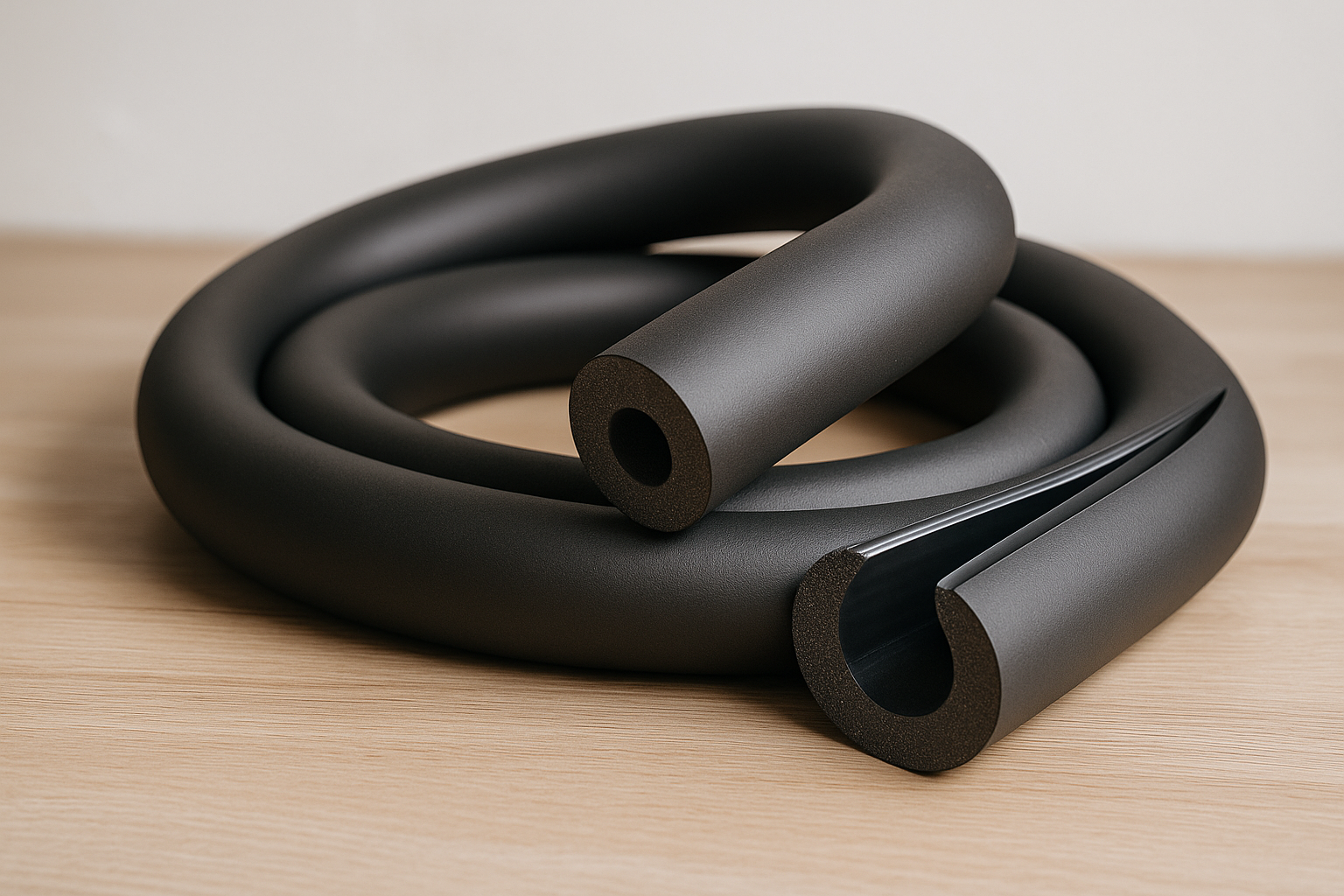Looking for reliable pipe and duct insulation that resists condensation and stands up to busy plantrooms?
K-FLEX ST Plus is a closed-cell elastomeric insulation with a built-in vapour barrier, designed for chilled water, HVAC, refrigeration and hot-water services. It delivers low thermal conductivity, very high water-vapour resistance and proven Euroclass fire ratings — all in a flexible, easy-to-fit format.
Closed-cell elastomeric foam High μ vapour resistance Low λ (thermal conductivity) Euroclass fire ratings -40 °C to +85 °C (ST Plus range*)
Why choose K-FLEX ST Plus
- Controls condensation: high water-vapour resistance (μ ≥ 10,000 for ≤25 mm thickness) helps keep the surface above dew point and protects against moisture ingress.
- Efficient thermal performance: λ as low as 0.033 W/m·K at 0 °C on thinner sections reduces heat gain/loss and helps maintain system efficiency.
- Fire performance you can specify: Euroclass ratings for tubes and sheets (e.g., BL-s2,d0 / B-s3,d0 depending on form) to support compliance.
- Corrosion-aware: pH-neutral material supports corrosion prevention under insulation strategies.
- Wide application window: typical temperature range for ST Plus pipes/sheets around -40 °C to +85 °C (check the specific product form).
Key specifications (at a glance)
| Property | Typical value / classification | Notes |
|---|---|---|
| Thermal conductivity λ | ≤25 mm: 0.033 W/m·K @ 0 °C (0.037 @ +40 °C) | Thicker sections: 0.036 @ 0 °C; 0.040 @ +40 °C. :contentReference[oaicite:6]{index=6} |
| Water-vapour resistance μ | ≤25 mm: ≥10,000; >25 mm: ≥7,000 | Built-in vapour barrier (closed-cell). :contentReference[oaicite:7]{index=7} |
| Temperature range* | Approx. -40 °C to +85 °C (form dependent) | See the data sheet for your exact product variant. :contentReference[oaicite:8]{index=8} |
| Fire (Euroclass) | Tubes: BL-s2,d0 or BL-s3,d0; Sheets: B-s3,d0 | Per EN 13501-1 classification. :contentReference[oaicite:9]{index=9} |
| Corrosion prevention | pH ≈ 7 (neutral) | Supports CUI mitigation practices. :contentReference[oaicite:10]{index=10} |
*Temperature limits and fire classes vary by format (tube, sheet, adhesive-backed). Always confirm with the current K-FLEX ST Plus data sheet for the exact SKU you’re buying.
Where K-FLEX ST Plus excels
- Chilled-water and HVAC lines - minimise condensation risk and energy gains.
- Refrigeration suction lines - reduce frost/condensate and protect adjacent finishes.
- Domestic hot water (DHW) and heating pipes - limit heat loss and improve response.
- HVAC ducting (sheet/roll) - thermal and surface condensation control on supply/return. :contentReference[oaicite:12]{index=12}
How to pick thickness (condensation-first sizing)
For cold lines, your priority is stopping condensation: the insulation must keep the outer surface above the ambient dew point. Use this quick approach:
- Gather conditions: fluid temperature, pipe OD/material, ambient air temperature, relative humidity, air movement.
- Find dew point: from ambient temperature and RH (any psychrometric calculator).
- Choose thickness: pick the smallest wall thickness that gives a calculated surface temperature ≥ dew point (use the K-FLEX calculator or your consultant’s tool).
- Add safety margin: if RH is high or airflow is limited (cupboards/shafts), step up one thickness.
For hot lines, size for heat-loss limits and touch temperature; for ducts, add surface condensation control into the decision. Always check fire and space constraints.
Installation guide (step-by-step)
What you’ll need: sharp knife, straightedge, tape measure, manufacturer-approved contact adhesive & tapes, clean cloths, PPE.
- Prep & plan: Surfaces must be clean, dry, dust-free. Measure pipe OD and select matching tube ID (or cut sheet to wrap). Dry-fit around valves, supports and fittings.
- Cut cleanly: Use a fresh blade for square cuts. For bends, make mitre cuts; for tees, template and pre-cut collars to maintain full thickness.
- Adhesive application: Brush a thin, even film of approved contact adhesive to both faces (tube slit edges / sheet overlap). Allow tack-off per datasheet.
- Close & press: Bring edges together without gaps; press along the seam from one end to the other. Roll or hand-press to ensure full bond.
- Seal every joint: Tape or over-brush seams, butt joints and terminations to maintain the vapour barrier - especially on chilled lines.
- Detail supports: At hangers, use compatible insulated pipe supports to avoid compression/bridges; seal transitions. :contentReference[oaicite:13]{index=13}
- Weather/UV (if exposed): For outdoors or high-traffic zones, over-jacket with suitable cladding or specify the appropriate protected system per K-FLEX guidance. :contentReference[oaicite:14]{index=14}
Common mistakes to avoid
- Leaving unsealed seams/gaps on chilled services - condensation will find them.
- Crushing the insulation at supports - use insulated saddles and keep continuity.
- Skipping solvent compatibility checks near EPS/finishes - follow adhesive guidance.
- Using indoor-only insulation unprotected in external UV-exposed locations.
FAQs
What thickness should I use for chilled-water pipes?
It depends on fluid temperature, pipe size, ambient temperature and RH. Select the minimum thickness that keeps the surface above dew point; when in doubt, step up a thickness and ensure all seams are sealed. (Your consultant or our team can help run the calculation.)
Does ST Plus work on ducts?
Yes - use sheet/roll format for ducting. It helps reduce heat gain/loss and surface condensation when detailed correctly.
What about fire performance?
ST Plus carries Euroclass ratings (e.g., BL-s2,d0 / B-s3,d0 depending on form). Confirm the class for the exact product and thickness you’re installing.


